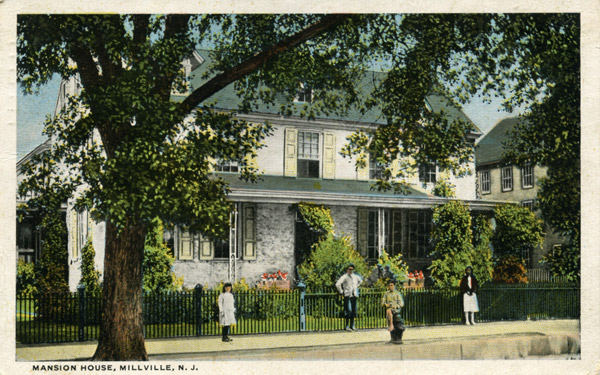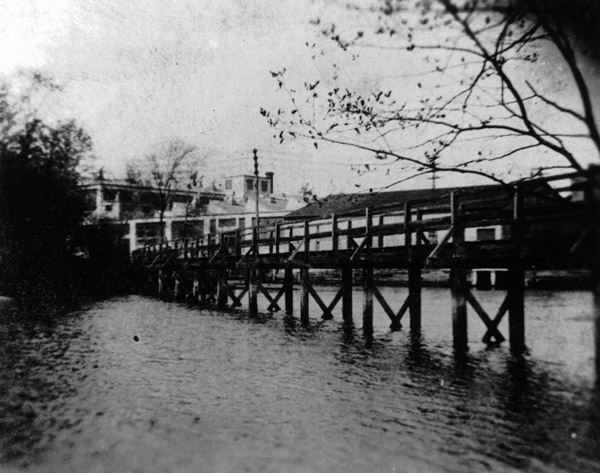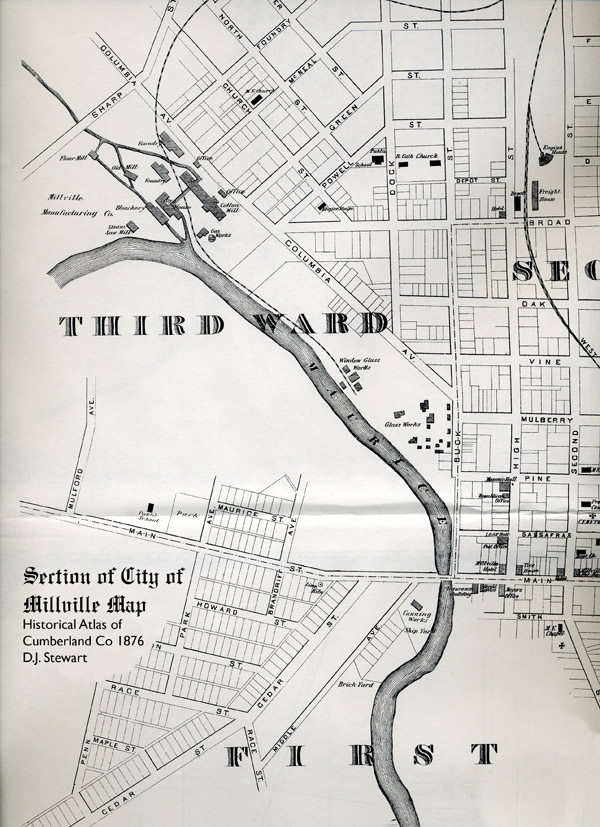Debra A. Barsotti
Research Journalist
Citizens United to Protect the Maurice River
and Its Tributaries, Inc.
The Maurice River Reaches Project
Bleachery
Reach #2
In 1919 a bleachery and a dye house were added to the facilities of Millville Manufacturing Company. Richard D. Wood established the  company in 1854, not long after the Union Canal was enlarged (post card of Wood Family Mansion across Columbia Ave from Co c.1918). The canal provided waterpower to operate the manufacturing site which, by 1883, had over 700 looms. By the time the bleachery and dye house were added, the mill was producing 250,000 yards of cotton material a week. The finished products would be transported down the Maurice River on schooners (post card c. 1907 showing schooner & Cotton Mill postcard c. 1913).
company in 1854, not long after the Union Canal was enlarged (post card of Wood Family Mansion across Columbia Ave from Co c.1918). The canal provided waterpower to operate the manufacturing site which, by 1883, had over 700 looms. By the time the bleachery and dye house were added, the mill was producing 250,000 yards of cotton material a week. The finished products would be transported down the Maurice River on schooners (post card c. 1907 showing schooner & Cotton Mill postcard c. 1913).
The 1876 Atlas of Cumberland County shows the Millville Manufacturing Company in the "third ward", situated on the east side of the Maurice River. The facility was bordered by the river, Sharp Street on the north and Columbia Avenue on the east. The large complex included several foundries, a steam sawmill, a flourmill, something marked "old mill", two office buildings, a gas works, a cotton mill and the bleachery. On the atlas map, it appears as though channels or canals connected some of these facilities. A railroad line also bisected the complex.
 A trolley service stopped at the cotton mill entrance on Columbia Street and a wooden structure, the Gangway Bridge, made an easy crossing for workers who lived on the other side of the Maurice River.
A trolley service stopped at the cotton mill entrance on Columbia Street and a wooden structure, the Gangway Bridge, made an easy crossing for workers who lived on the other side of the Maurice River.
Local resident Everett Turner, who has provided plumbing and heating services in the area for decades, had a stint at the Millville Manufacturing Company. "I worked one time there for 6 months," he said. "I learned my trade from my brother in Vineland, plumbing, heating. He was 21 years older than I was - and, like all families, we feuded." Turner chuckled, remembering his youthful impulses. "Well, I got mad at him one time - and I quit. I went to work in the cotton mill for 6 months - and then I had to go and beg for my job back." Turner said it wasn't the mill work that bothered him, though many accounts indicate that the workday was long and tedious. " I couldn’t stand it in there, being locked up indoors," Turner admitted (some inside photographs of Millville Manufacturing)
 Richard Weatherby was familiar with the cotton mill. "It was up there at the head of the lake, right there below the dam." He had one distinct memory: "I remember that when they would change their dye in their vats, the carp would be tinted blue or yellow - or whatever [color] they were running at the time."
Richard Weatherby was familiar with the cotton mill. "It was up there at the head of the lake, right there below the dam." He had one distinct memory: "I remember that when they would change their dye in their vats, the carp would be tinted blue or yellow - or whatever [color] they were running at the time."
The primary manufacturer on site was "Alcan Packaging Pharmaceutical Co.", which was purchased by Amcor Packaging Company in 2010.
 click to navigate the map "up".
click to navigate the map "up". click to navigate the map "down".
click to navigate the map "down". click to navigate the map "left".
click to navigate the map "left". click to navigate the map "right".
click to navigate the map "right". click to "zoom in" for a closer look.
click to "zoom in" for a closer look. click to "zoom out" to back away from the map.
click to "zoom out" to back away from the map. click to get back to the "default" map setting.
click to get back to the "default" map setting. click to learn more about that reach.
click to learn more about that reach.


